Sloe Gin is a delicious traditional treat. This simple sloe gin recipe needs only four ingredients – sloes, gin, sugar and, crucially, time!

Sloe Gin
Sloe gin is a traditional British after-dinner digestif. Smooth and fruity, with its own unique flavour, I love a glass at the end of dinner.
It’s a real autumn and winter treat, flavoured with fruit from the hedgerow, perfect beside warming fires for cosy evenings at home, enjoying long winter evenings: the British version of hygge.
This sloe gin recipe needs only four ingredients: sloes, gin, sugar and time.
There’s something wonderful about having a couple of bottles at the back of a cupboard, gently maturing and gaining flavour from the foraged fruit, ready for the great decanting.
I find that leaving the fruit in for a good long while is really worth it; I usually leave my sloes infusing for a year and decant at the same time as I make the next batch. Once decanted the drink ideally benefits from a couple of months to mature.
Don’t leave it too long, however. The bottle needs drinking within a few years of decanting. Very old sloe gin loses its colour and flavour.
How to Identify Sloes
Sloes are the fruit of the blackthorn tree and are usually ready to pick in late September to October. They’re a small, round fruit, far too bitter to eat straight from the tree, but wonderful for flavouring gin.
Don’t confuse sloes with bullaces (wild damsons), which are similar in colour with the same ‘bloom’ to the fruit and only slightly bigger. If in doubt, look for thorns on the branches. If the tree has thorns, you are picking sloes and not damsons.
It’s a great idea to identify the white blossom in spring, and make a note of where the trees are for harvest in autumn.
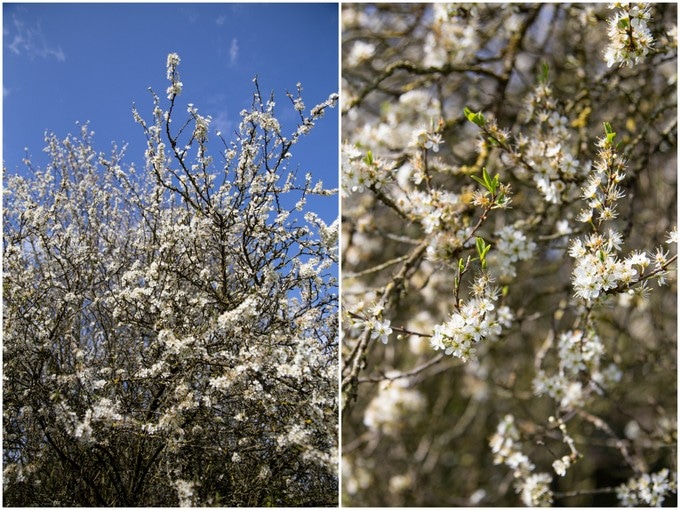
Of course, both bullaces and damsons make good sloe substitutes and are delicious when infused in gin. I’m sure many people have used all three, separately or in a mix.
Apparently some people mistake the toxic berries of Atropa belladonna or deadly nightshade for sloes. This is a much more serious mistake. However, it is not hard to tell the plants apart.
Deadly nightshade is a relative of the potato plant. It is herbaceous plant with no wood, so shouldn’t be easily confused with the woody, thorny blackthorn tree, but it can grow up high through other trees.
Nightshade leaves are different in texture and shape from those of the blackthorn, The berries are blacker and shinier than sloes, without the blue bloom, and they protrude from a calyx. Sloes grow on woody branches. However, if you are in any doubt at all, ask someone who knows about wild plants to help you check.
As with all foraged fruit, try to pick from a tree that isn’t too close to a main road and from branches high enough to be out of the way of passing dogs and other animals. When picking them, make sure you have permission from the landowner and do take care to avoid scratches!

When to Pick Sloes
Sloes ripen from mid September to October, it depends on where they are growing and how hot the summer has been.
It is traditional to wait until after the first frost to pick them, but it doesn’t make that much difference to the flavour, and if you leave them you run the risk that someone else will find them and pick your sloes!
You can test for ripeness by squeezing them; they will have a little give, but will not be soft like a ripe plum. If they are still hard then leave them and return in a few weeks.
We keep a few empty ice cream tubs in the car, along with an old walking stick, which is useful for pulling down out-of-reach branches when foraging.
Do You Need to Prepare the Sloes?
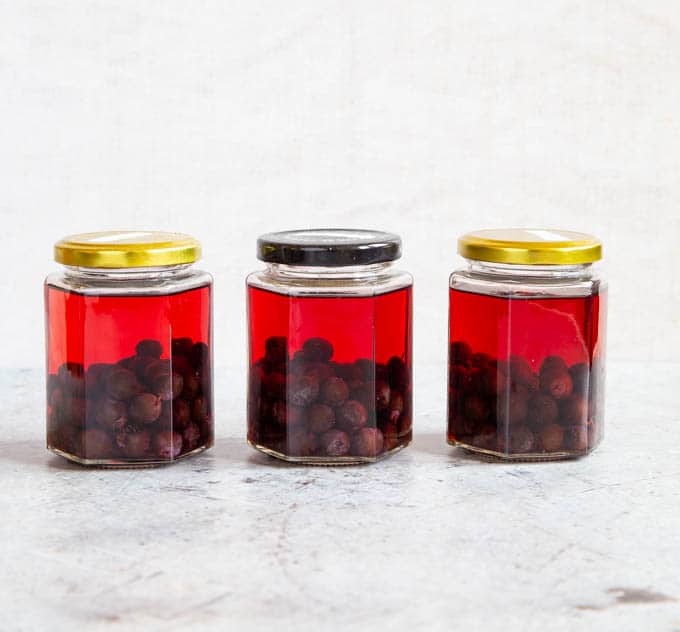
Traditionally, sloes were pricked with a needle before making sloe gin, or frozen so that the skin splits. However, there is no difference in results if either of these steps are missed, and you simply add whole sloes.
The three jam jars shown above are made with, from left to right, untouched, pricked and frozen sloes. As the photo shows, there is no difference in results after one month’s infusion.
Just pick over the sloes and remove leaves, twigs and any mouldy or damaged fruit. If you can’t make gin straight away, there’s no harm in freezing the fruit. You needn’t wait until the fruit has defrosted before starting to make gin.
How to Make Sloe Gin
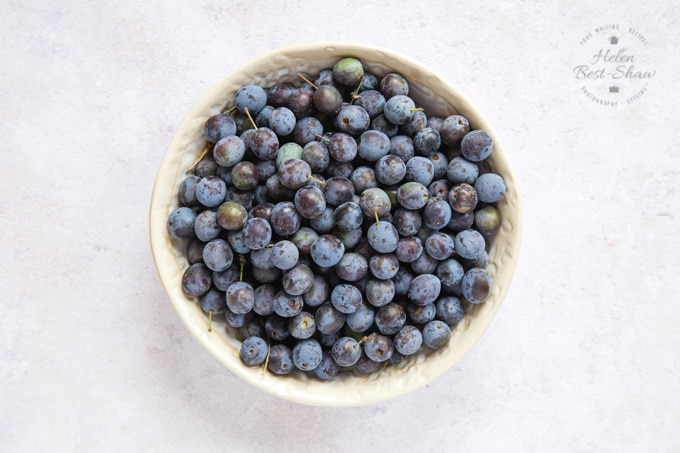
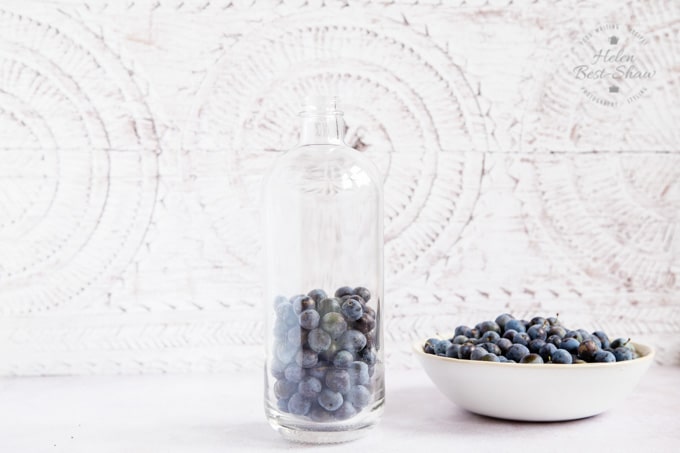
Step one – Gather your sloes, pick them over and remove any that are soft, or split. Remove leaves and twigs, but you can leave the stalks.
Step two – Take a clean glass screw-top bottle. Weigh it and note the weight. Then fill it to between a third and two fifths with sloes. You can add them whole, pricked or from the freezer. Weigh the bottle again and work out the weight of your fruit.
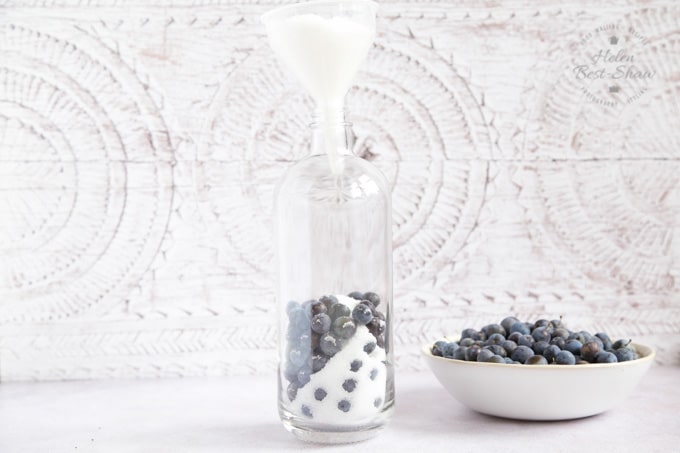
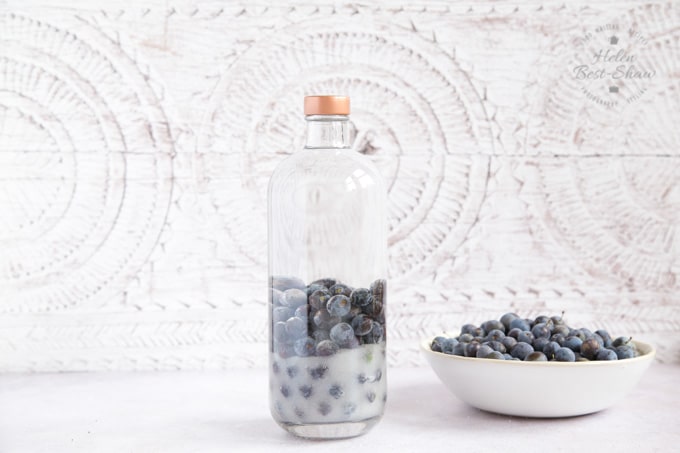
Step three – Work out the quantity of sugar that you need – it should be 60% of the weight of sloes. Add this to the bottle (I find a small funnel is useful here). If you don’t have a sweet tooth, use less sugar. You can always add more later.
Step four – Fill the bottle with gin. (I use supermarket dry London gin; not the cheapest, but nothing expensive. The fancy botanicals in the more glamorous brands may be drowned out by the sloes or worse, fight against the flavour.)
My mother leaves gap at the top, to make the shaking easier, then tops up once the sugar has dissolved.
Give the bottle a shake, and keep it somewhere accessible. Give the bottle a shake every day to dissolve the sugar.
Some people pack the sloe gin into a box put in the back of the car and drive it around until the sugar has dissolved. The vibrations from the car will do the work for you.
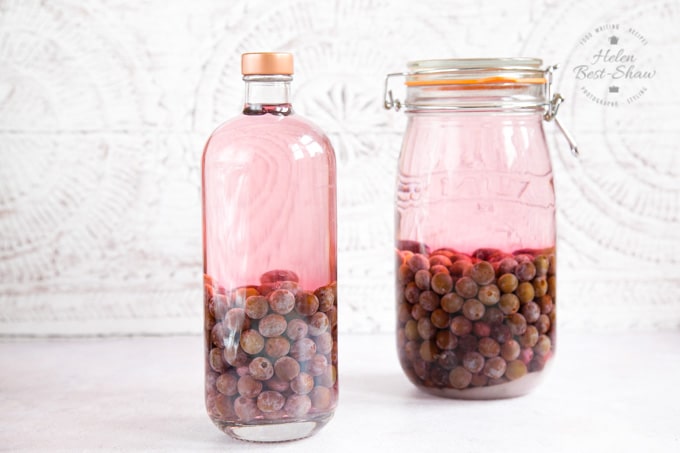
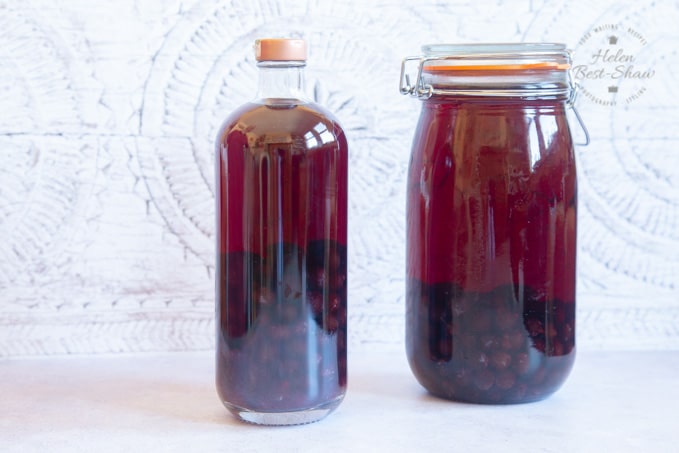
Step five – Once all the sugar has dissolved, store in a cool, dark cupboard. At this stage it will have that first tantalising blush of pink.
Step six – Leave it for at least three months, by which point it should be a deep red colour. We usually leave it for a year.
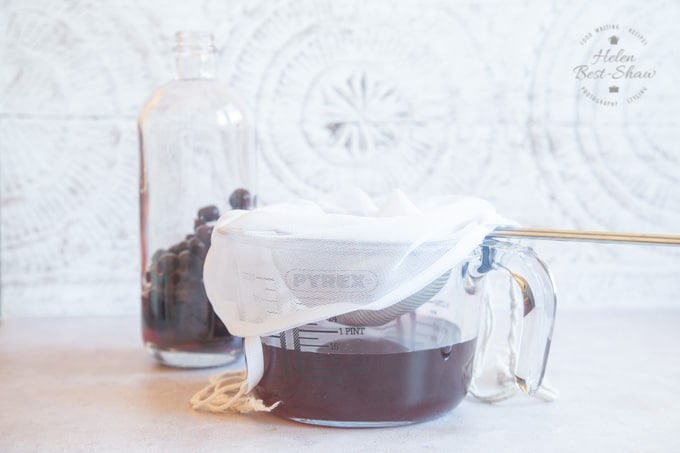

Step seven – Decant the gin from the sloes with a sieve and jelly bag or muslin cloth. Bottle the liquid in a clean bottle.
You can enjoy it immediately, but we like to let it mature further for about six months. It keeps well for up to five years or so, but does lose some of the flavour if really ancient.
How to Use Sloes From Sloe Gin
Sloe gin comes with a fabulous bonus byproduct – gin-soaked fruit! Don’t waste it. Put them in a jar, cover with sherry and leave for a secondary infusion for 6 weeks. Or try one of these uses:
- Add to the fruit when making blackberry or apple jelly.
- Fill the cavity of a pheasant when roasting, and serve with a sloe gin and cream sauce.
- Tie into a muslin cloth and add to the pot when making mulled wine.
Sloe Gin Ingredient Ratios
To fill a 70cl or empty wine bottle
225 g sloes
120 g sugar
410 ml gin (or enough to fill the bottle)
To fill a litre bottle
320 g sloes
170 g sugar
570 ml gin (or enough to fill the bottle)
Hints, Tips & Variations
- For speed and volume you can infuse the sloe gin in a Kilner style preserving jar. This is especially good if you are using damsons or bullaces, which do not always fit through the neck of a regular bottle.
- Adjust the sugar to taste – remember that you can add more, but not take it out.
- If you experiment with the quantities, write down what you used on a label and stick it to the bottle. It is intensely frustrating to make the best batch ever and have no idea of the recipe you used.
- You can save the infused sloes for all sorts of things, but don’t be tempted to reuse them for another batch of gin. It doesn’t work and is a waste of gin, sugar and time!
- Experiment with a few spices. I usually do this in a small bottle when testing. A little goes a long way so only put a tiny amount in. Star anise, cardamon or cinnamon are popular additions.
- Don’t use expensive gins with complicated botanicals or added flavours for this sloe gin recipe – instead, use a simple gin and allow the sloes to take the starring role.
- If you are not a gin drinker, then of course vodka can be used.
- Three months will do, but steeping the fruit for six months to a year is better to maximize the flavour. Ideally, leave it for few months more after rebottling the finished gin.
- Sloe gin can be mixed with prosecco for a Christmas treat or added to mulled apple juice or cider. It is also delicious in a long summer drink with tonic water and lots of ice – if you have any left, that is.

How to Find Sloes
- Go for some country walks and keep your eyes open – you will see the unripe berries from the middle of the summer. Remember where they are and come back and harvest them later. We return to the same spot year after year.
- If you revisit the spot in the spring when the blackthorn is in blossom, you can easily identify more blackthorn in the surrounding area from across a field.
- Ask people. Most are not going to tell you where their favourite spot is, but they will probably point you in the right direction.
- If you don’t have time to look for and pick sloes, you can buy them on eBay for about £4 a pound!
More winter cocktails and drinks
More homemade liqueurs and infusions
- Rhubarb and ginger gin – pretty pink and so so delicious.
- Christmas Gin – All the flavours of a Christmas pudding makes this infusion perfect for presents.
- Christmas Vodka – rich spiced vine fruits and ready in less than a week!
- Cranberry Gin – Jewel coloured cranberry and orange gin – perfect for Christmas sipping!
- Bramble Whisky – packed with blackberries and sloes, this is an ultimate winter warmer.
Sloe Gin
Ingredients
- 225 g sloes
- 120 g sugar
- 410 ml gin ((or enough to fill the bottle))
Instructions
- Pick over the sloes and put them in a clean 70 cl bottle.
- Add the sugar.
- Top up with the gin.
- Screw the lid down tight and give it a good shake.
- Keep the bottle in a cool, dark place that is easily accessible and shake every day for the first week or so, until all the sugar is dissolved.
- Store in a cool dark place for at least 3 months (ideally at least months to a year) to infuse.
- Strain into a jug through a sieve lined with a muslin cloth or jelly bag. Transfer the gin to a clean bottle. The gin may be enjoyed straight away but is best left for another 6 months.
Notes
- This recipe is 2 Weight Watchers Smart Points
Video
Update Notes: This recipe was originally posted in November 2010, but was rewritten and republished with new photos, step by step instructions and hints & tips in September 2019.
Make the most of the hedgerow harvest. If you enjoy sloe gin, I think you will love my sloe ice cream and sloe syrup.


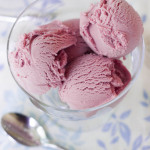
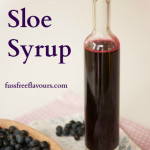










meemalee
I can vouch for this recipe – beautiful stuff!
This may be a dumb question – can you eat the sloes afterwards?
Helen
You can eat them, but they are a little tough, and all stone and little flesh.
I have used to to stuff game of various sorts. A recipe will be coming!
meemalee
Oh, that is such a good idea! And makes a change from apricots :)
Kavey
We tried a sip at Sue’s – lovely!
Jacqueline
I have never tried sloe gin, but I am still sitting here and thinking mmmmmm :P
Pamela
Sloe gin is lovely, although I’ve never tried making my own. Must add it to the list for next summer.
Jacqueline Debono
I love the idea of homemade sloe gin! I’m not sure if sloes grow where I live (north Italian countryside) but am going to look out for them or ask a local farmer! Funny that people drive around with the sloe gin in the car to help dissolve the sugar!
Miranda
This brings back such lovely memories of childhood. Out foraging with my parents, and watching my Mother prepare the bottles. I was always confused about why she put them away in the pantry, no understanding of the time it took, obviously. I would love to try to make my own now.
Helen
I remember my father hooking the branches down with an ancient hockey stick
Susan Robinson
Great advice about picking the right berries! Very important.
Sloe gin is delicious, and worth the wait. And makes a wonderful present.
Danielle Wolter
What a wealth of information! there are so many great tips and tricks in this article. Thanks fro the great info and recipe!
Romina
This is so informative! Thank you for sharing.
Pam Greer
Nothing I like better than infusing gin!! I hate the sloe gin that you get at the stores, it’s nothing at all like the real thing!
Helen
the shop stuff is simply horrible, and terribly overpriced for what it is.
Emese
Wow, so informative. I got to know everything there is to know about sloes. Thanks so much. Adding it to my must-have list.
Helen
Everyone needs to make sloe gin at least once.
Chrissy
Thank you for all this information. I found some trees recently and I’m keen to try again. The berries were hard, then 2 weeks later when I picked them I found half the berries were part to fully dried up like raisins. I know you can flavour gin with grape raisins, would it work with these? If so, what would be the right weight ratios for berry/ sugar/ gin? Would they still need pricked?
Secondly, has anyone tried lightly mashing or pressing berries to split them?
Helen
Hi Chrissy,
I think that the dried sloes would be fine, maybe use a little less sugar and fill the bottle 2/3 with the gin – that way you can add more if needed. I’ve made sloe gin that was too weak before and had to decant into two bottles and leave until the autumn before adding more sloes.
Let me know how it goes.
Yvonne Wilder
I made this last year and it was a great success. I was delighted with the results. I am keeping an eye on the patch of sloes I picked from last time and hopefully will get enough to make more this year.
Helen
There is nothing like your own patch of sloes!
Debs
Certainly worth the wait. Last year’s batch has been enjoyed and has now gone. Look forward to making it again.
Helen
Always worth the wait!
Siobhan
I am so excited, and pleased to tell you that I found a great patch of sloes and have started this off. So happy!
Nancy
It is that time of year again, and I’m delighted to have made this again. Last years bottles have all gone, or been passed on. Really good stuff.
Hollie Jackson
I’ve had a great time swapping my batch from last year to the new batch. Managed to get a good haul of sloes, enough for four bottles! So much fun collecting, and preparing. The best bit is still to come, enjoying it.
Lorna Hindmarsh
Great advice, Helen, and so good to make this. I can’t believe people would actually mistake deadly nightshade for sloes! Scary.
Debbie
Hi,
I live in Canada and we have many Hawthorn trees on our property. They have long thorns on the branches. The Bears are eating the berries right now. Do you know if a Hawthorn is similar to Blackthorn, or maybe the same?
This recipe sounds so good and easy to make.
Thank you,
Debbie
Helen Best-Shaw
I believe that it is completely different – sloes can be up very high too, and are purple, British hawthorns are deep red.
Rod
Good recipe – works well!